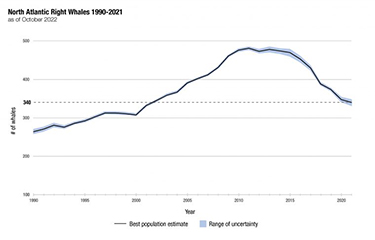Around 340 North Atlantic right whales remaining as population continues to decline

The population of North Atlantic right whales dropped 2.3 percent over the past year to an estimated 340 individuals, according to a report released Monday, 24 October by the North Atlantic Right Whale Consortium.
The downward trend was influenced by “ongoing human impacts that are hindering the critically endangered species’ ability to survive and reproduce,” according to the consortium, which was founded in 1986 by the New England Aquarium and partners from the University of Rhode Island, the Center for Coastal Studies, Marineland of Florida, and Woods Hole Oceanographic Institution as a collaborative means to better understand and protect the species. The group now has approximately 100 members that are engaged in right whale conservation efforts.
“While it is certainly good to see the slope of the trajectory slow, the unfortunate reality is that the species continues to trend downward, with fewer than 350 individuals alive in 2021,” North Atlantic Right Whale Consortium Executive Administrator Heather Pettis said.
The consortium estimated the North Atlantic right whale population at 340 (plus or minus seven) in 2021, down from 348 (plus or minus five) in 2020. An estimated 15 calves were born in 2022, down from 18 in 2021 and an average of 24 in the early 2000s.
“There were also no first-time mothers in the group, which supports the findings of a new paper on breeding females showing a downward trend in the number of female right whales capable of breeding,” the consortium said in a press release. “Research has also found concerning evidence of declining body size, in part due to frequent entanglements in fishing gear, with smaller female right whales producing fewer calves.”
U.S. and Canadian lobster fisheries and the snow crab fishery in the Canadian Maritimes have been jolted by legal and legislative moves aimed at protecting the surviving population of right whales. While the lobster industry claims there have been no confirmed entanglements of whales in lobster-fishing gear, and point out that right whales do not frequent waters where intensive lobstering occurs, the consortium said thus far in 2022, there have been five whales seen entangled in fishing gear and five others that suffered injuries as a result of interactions with fishing gear, without specifying what type of gear entrapped the whales. There was also one detected vessel strike to a right whale in 2022. While it said no right whale mortalities have been confirmed for 2022, it said one entangled whale, named Snow Cone, and its calf are unlikely to survive.
“There has been a lot of focus on the fact that no right whale mortalities have been detected in 2022, which is certainly a good thing. While we can be cautiously optimistic about this, we know that only one third of right whale deaths are observed, so it is likely that some whales have died this year that were not observed,” North Atlantic Right Whale Consortium Chair Scott Kraus said. “Additionally, we continue to see unsustainable levels of human-caused injuries to right whales. A lot of work by many stakeholders has gone into protecting these whales, but the hard truth is it hasn’t been enough.”
Philip Hamilton, a senior scientist at the New England Aquarium and the identification database curator for the consortium, noted the North Atlantic right whale population is now at the same level it was in 2001, before it recovered to reach nearly 500 individuals by the mid-2010s.
“This species can recover if we stop injuring and killing them,” Hamilton said.
Environmental nonprofit Oceana issued a statement following the release of the latest population estimate calling for further protection of right whales.
“Every year that passes without meaningful government action is devastating for the survival of North Atlantic right whales,” Oceana Campaign Director Gib Brogan said. Fisheries, politicians, and the U.S. government need to work together to enact solutions to save this critically endangered species from inching closer to extinction. Given the inadequate safeguards that are in place, the new population and mortality estimates for North Atlantic right whales are sadly predictable and frustrating. As we have consistently done in the past and do again today, we’re calling on the federal government to step in and establish real protections for these whales and create an actionable plan with solutions to help fisheries continue to thrive – both are possible.”
Separately, on 21 October, 2022, NOAA Fisheries and the Bureau of Ocean Energy Management (BOEM) announced the release of a draft joint strategy to protect and promote the recovery of North Atlantic right whales while responsibly developing offshore wind energy.
The draft strategy, which is open for public comment through 4 December, 2022, seeks to identifies the agencies’ goals and objectives to better understand the effects of offshore wind development on the whales and their habitat. U.S. President Joe Biden is pushing for the development of 30 gigawatts of offshore wind by 2030.
“As we face the ongoing challenges of climate change, this strategy provides a strong foundation to help us advance renewable energy while also working to protect and recover North Atlantic right whales, and the ecosystem they depend on,” NOAA Fisheries Assistant Administrator Janet Coit said. “Responsible development of renewable energy sources and protecting endangered North Atlantic right whales are priorities both agencies share.”
Image courtesy of North Atlantic Right Whale Consortium






Share